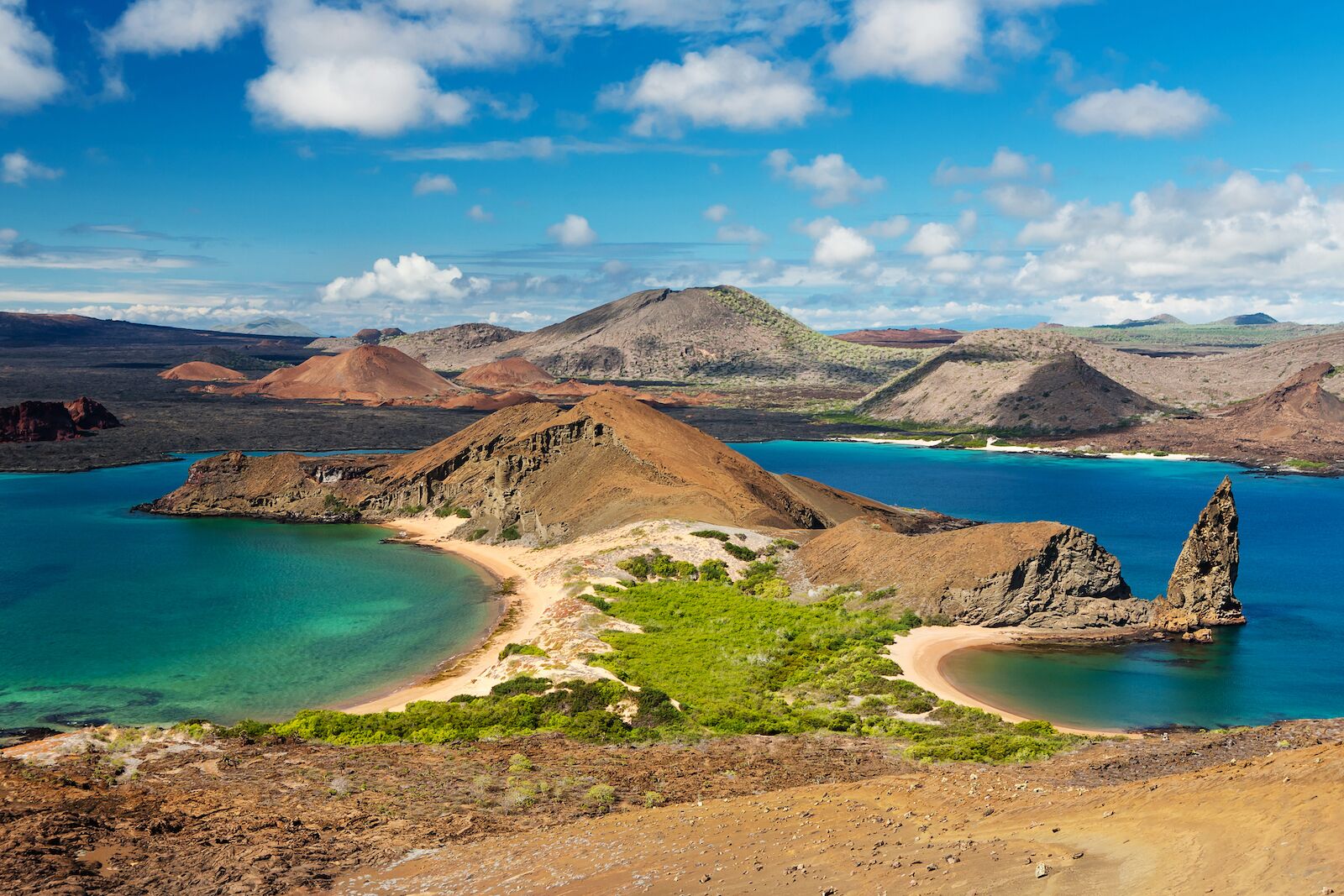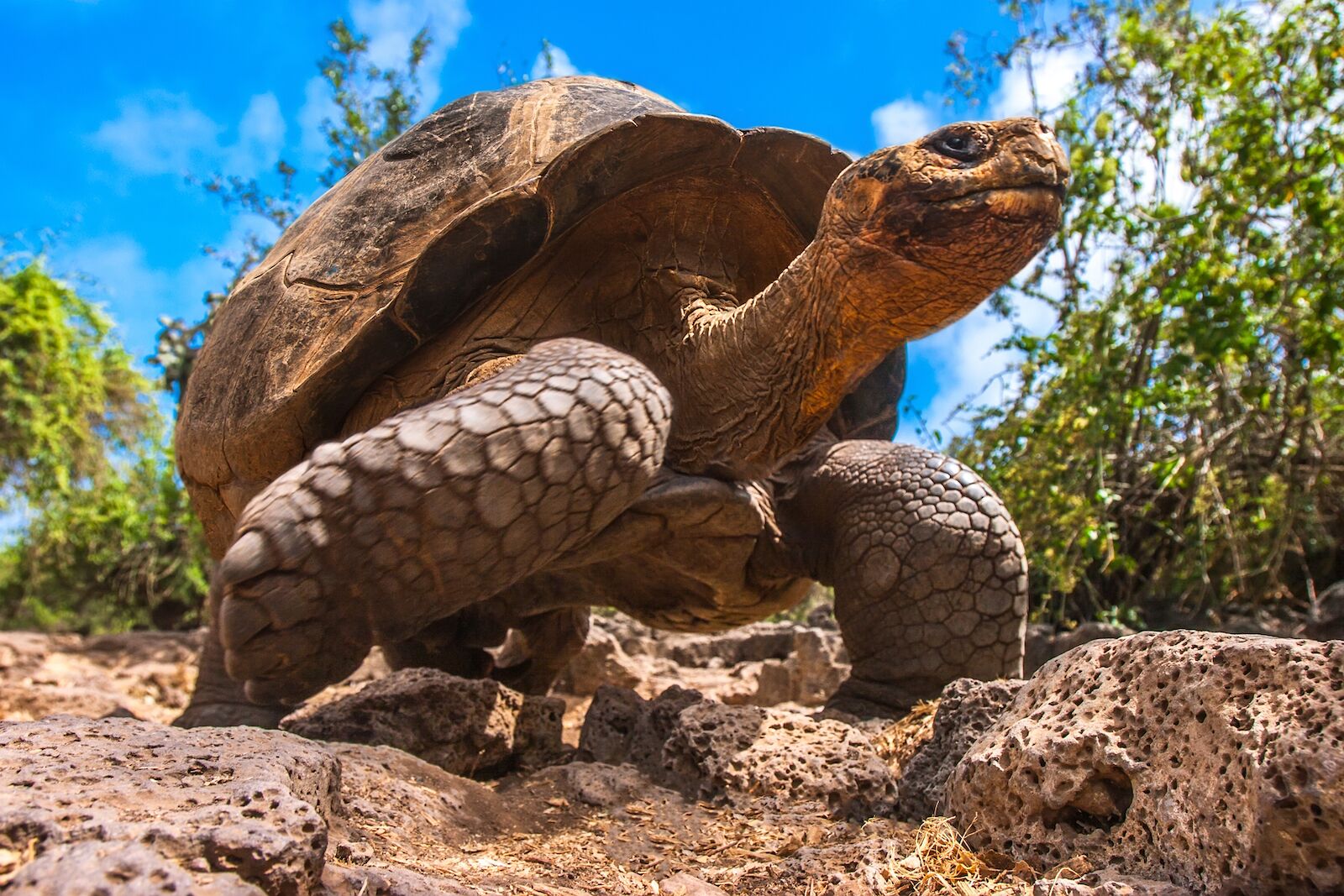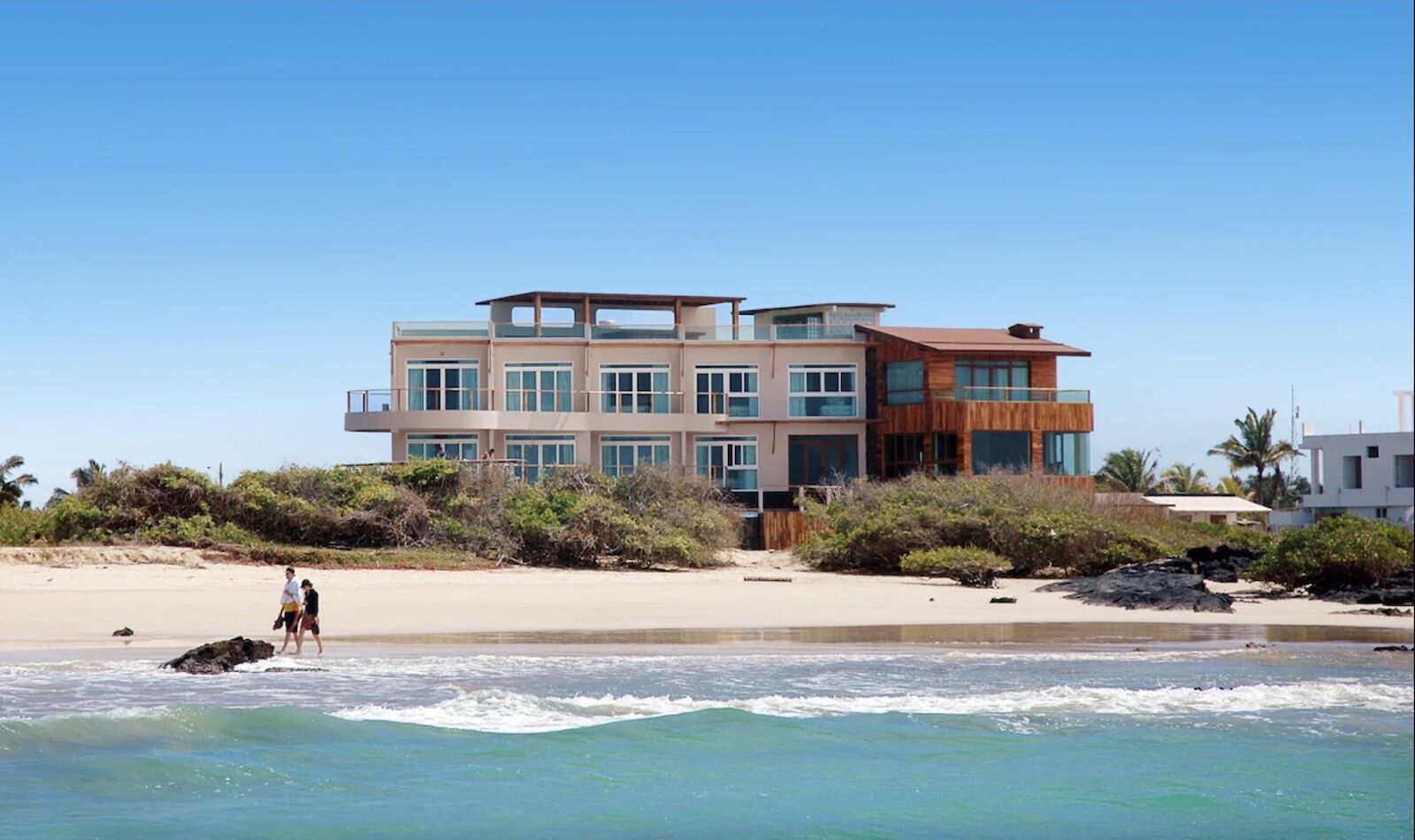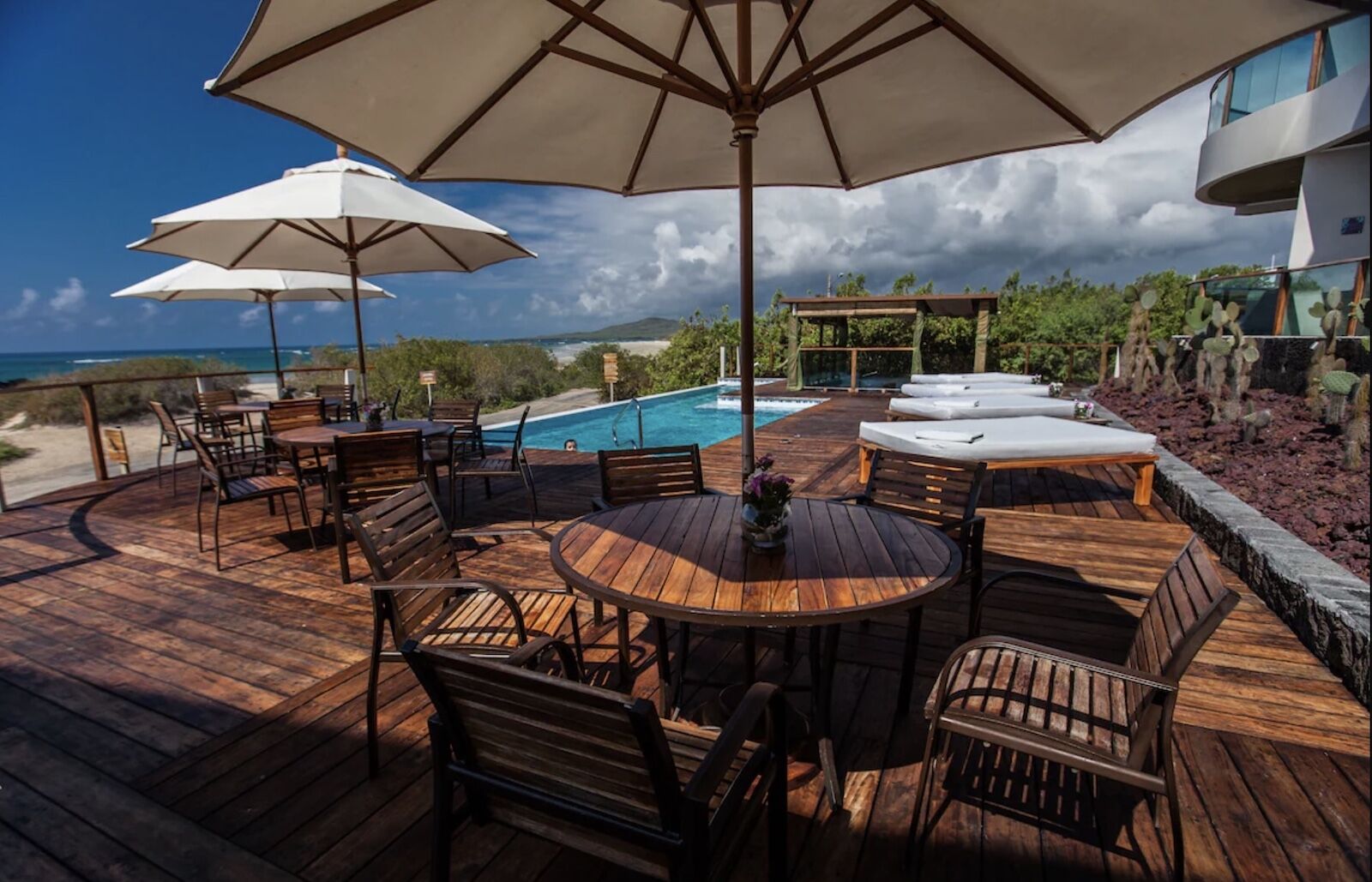There’s only one place on Earth where you can see swimming iguanas, lava lizards, and giant tortoises: the Galápagos Islands. A UNESCO World Heritage site since 1978, the archipelago off the shore of South America is a must-visit destination for anyone with a passion for fauna and flora, and their protection. 97 percent of the land was designated as a national park in 1959, and over 51,000 square miles of ocean around the islands have been a protected marine reserve since 1986, making for a destination where you’re a guaranteed to be immersed in nature and observe unique wildlife.

These Remote Islands Whose Name Translate as "Tortoises" Are Full of Swimming Lizards
- Where are the Galápagos Islands?
- Who owns the Galápagos Islands?
- Do the Galápagos Islands have their own flag?
- How many islands are there in the Galápagos?
- Do people live on the Galápagos Islands?
- How were the Galápagos Islands formed?
- Who discovered the Galápagos Islands?
- What are the most iconic animals of the Galápagos Islands?
- What did Charles Darwin observe on the Galápagos Islands?
- How to get to the Galápagos Islands?
- What is there to do on the Galápagos Islands?
- Galápagos Islands hotels
Where are the Galápagos Islands?
The Galápagos Islands are located in the eastern Pacific Ocean, almost directly on the Equator. The islands are around 620 miles (1000 kilometers) from the South American coast.
Who owns the Galápagos Islands?
The Galápagos Islands are a province of the South American country of Ecuador.
Do the Galápagos Islands have their own flag?
Every Ecuadorian province has its own flag, and so do the Galápagos Islands whose flag consists of three horizontal bands of equal size and three different colors: green, white, and blue.
How many islands are there in the Galápagos?

Photo: npavlov/Shutterstock
The Galápagos is an archipelago that consists of 13 major islands, as well as some smaller islands and rocky islets. Figures about the total number of islands differ from source to source.
The 13 major islands of the Galápagos are:
- Isabela Island
- Santa Cruz Island
- Fernandina Island
- San Cristóbal Island
- Santiago Island
- Floreana Island
- Santa Fe Island
- Pinzón Island
- Española Island
- Baltra Island
- Pinta Island
- Marchena Island
- Genovesa Island
Do people live on the Galápagos Islands?
According to UNESCO, there are around 30,000 people living on four of the main islands: Santa Cruz, San Cristóbal, Isabela Island, and Floreana. However, The Galápagos Conservancy, a non-profit organization whose goal is to protect the flora and fauna of the islands, estimates that there are less than 20,000 inhabitants spread around the same islands.
How were the Galápagos Islands formed?
The islands were formed by seismic and volcanic activities that occurred along the boundary of the Nazca tectonic plate. The islands are simply layered piles of volcanic lava. There are still active volcanoes on the islands like Cerro Azul, Wolf, and Sierra Negra on Isabela Island, and Fernandina on Fernandian Island.
Not all the islands of the archipelago were formed at the same time. Española and San Cristóbal islands are believed to be between 3 to 5 million years old, while Isabela and Fernandina islands are less than one million years of age.
Who discovered the Galápagos Islands?
The islands were discovered in 1535 by Fray Tomás de Berlanga, the then Bishop of Panama. While he was on his way from Panama to Peru, Fray Tomás’ ship unintentionally landed on the islands that were, at the time, devoid of humans.
What are the most iconic animals of the Galápagos Islands?
The most well-known animal living on the archipelago is the giant tortoise. Giant tortoises are the largest living tortoise in the world and they can only be found in the Galápagos. It is not a coincidence that the term “galápago” in Spanish means “tortoise”.
Other iconic species of the islands are:
- The Galápagos penguin: The only penguin species found north of the equator, it is endemic to the island.
- The marine iguana: The world’s only oceangoing lizard, it is endemic to the island.
- The blue-footed booby: One of the three booby species on the islands, this large bird sports bright blue feet.
- The Galápagos lava lizard: Those reptiles who sunbathe on top of lava piles are endemic to the islands.
- The Galápagos sea lion: One of six mammal species present on the islands and the largest animal found on the archipelago.
What did Charles Darwin observe on the Galápagos Islands?

Photo: FOTOGRIN/Shutterstock
Charles Darwin visited the archipelago in 1835 as part of his voyage on the HMS Beagle. During his stay, he made critical observations of the local flora and fauna. He was particularly intrigued by the variations among species from island to island. For instance, he discovered several species of finches, where each species had a uniquely shaped beak — a feature he attributed to the differences in their diet and lifestyle. Similarly, he noticed that the Galápagos tortoises had longer necks compared to those found elsewhere, which he hypothesized allowed them to reach for more leaves and access more food. These observations played a pivotal role in shaping his groundbreaking theory of evolution by natural selection, suggesting that organisms adapt to their environment over generations to increase their chances of survival.
How to get to the Galápagos Islands?
You can fly from mainland Ecuador (Quito or Guayaquil) to either Seymour Galapagos Ecological Airport on Batra Island or Airport Isla San Cristobal on San Cristóbal Island. There are flights every day of the week with Avianca or LATAM Airlines. Note that you must have a return flight to be able to visit the islands.
Once your bookings and itinerary are all set, and before you depart for the islands, you’ll need to fill in the Transit Control Card (TCT), and pay the $20 fee associated with it. The government of Ecuador provides a useful step-by-step guide on how to fill in the TCT. The TCT allows the government to keep an eye on visitors numbers and overtourism at bay in the Galápagos. A $100 entrance fee to the Galapagos National Park is also necessary upon arrival. (The Galapagos National Park covers 97 percent of the islands.)
Upon arriving in the islands by plane, you and your luggage will go through a thorough check from the Galápagos Biosecurity Agency to make sure you’re not bringing in anything that may threaten the islands’ unique ecosystem.
Once in the Galápagos, you can opt to take a multi-day cruise with one of the many cruise companies available, or you visit the islands on day trips from a base on one of the inhabited islands. Because you’ll need to provide all your travel information in your TCT, you must have made your travel arrangements prior to traveling to the islands.
What is there to do on the Galápagos Islands?
The archipelago offers a rich array of nature-focused activities. Visitors can embark on guided tours to observe the unique wildlife, including giant tortoises, blue-footed boobies, marine iguanas, and the famous Darwin finches. Snorkeling and diving are popular activities, with opportunities to swim alongside sea turtles, playful sea lions, and even hammerhead sharks. The islands’ volcanic landscapes also provide excellent hiking trails, with impressive views from the peaks. For those interested in history and science, a visit to the Charles Darwin Research Station on the island of Santa Cruz provides valuable insights into Darwin’s work and the ongoing conservation efforts on the islands. For more ideas on what to on on the islands, check out Matador’s “10 things you can do in the Galápagos Islands other than look at tortoises“.
Galápagos Islands hotels
If you opt to travel independently around the islands on day trips or using public transports, you’ll need to book you own lodgings. The following hotels are the best-rated ones on Santa Cruz Island, Isabela Island, and San Cristóbal Island.
We hope you love the spaces and stays we recommend! Just so you know, Matador may collect a small commission from the links on this page if you decide to book a stay.
Hotel Cucuve
Next door to the national park and less than 15 minutes on foot from the Charles Darwin Research Station, Hotel Cucuve is a four-star property located on Santa Cruz Island. Hotel Cucuve provides free continental breakfast, free WiFi, and a coffee shop/cafe. The rooms are spacious, clean, and simply decorated. At reception, you can book day tours to visit the giant tortoise reserve or walk through lava tunnels. There is a shuttle to get you from and to Seymour Galapagos Ecological Airport on Batra Island.
Iguana Crossing Boutique Hotel
The Iguana Crossing Boutique Hotel is beach-front, modern, three-star property located on Isabela Island. There is a pool, free WiFi, and a buffet breakfast is included. There is an on-site restaurant and bar from where you can admire the view of the ocean. You can book tour packages from reception, including visits to the Sierra Negra volcano, giant tortoise refuge, and snorkeling tours.
Casa Playa Mann
Casa Playa Mann is a a family-run, sea-view property on San Cristóbal Island. The hotel offers air conditioning, free WiFi, and breakfast to its guests. The national park is next door and so are snorkeling and diving opportunities on Playa Mann just down the road. The hotel is located only a few minutes from Airport Isla San Cristobal.





